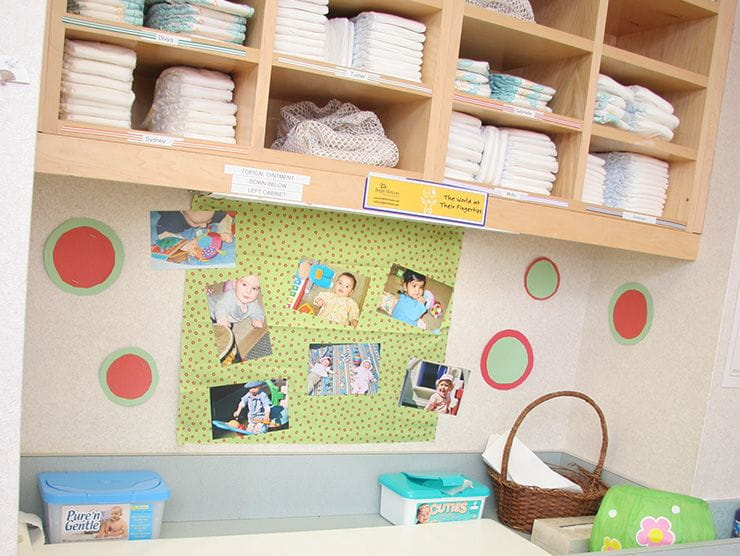Toilet Learning: Is Your Child Ready?
By waiting until your child is developmentally ready for “potty training,” or toilet learning, we protect them — and you — from undo stress. That means the process of teaching your child to use the toilet starts when they begin to show signs of readiness. These developmental signs include:
- Staying dry for long periods of time
- Talking about toileting, i.e., telling you they have gone to the bathroom in their diaper
- Able to connect the impulse to eliminate with the act of elimination
- Expressing discomfort with soiled/wet diapers
- Using words suggesting an interest in the toilet
- Asking about the toilet or underwear
- Indicating when it’s time to urinate or have a bowel movement
Toilet Learning: Are You Ready?
Here are a few questions you and/or your co-parenting partner should consider and discuss before you start the process of introducing your child to toilet learning. Likewise, it is recommended you discuss some of these considerations with your child’s teacher, and make a plan that carries from home to child care, and back — your partnership with teachers and other caregivers will play an important role in helping your child learn to use the toilet successfully.
- Can you dedicate a couple of days to stay close to home to start the process?
- Is your family facing a major change, such as moving to a new home or the birth of a baby?
- Are you prepared to wash additional loads of laundry?
- Do you have ample paper towels and cleaning products available?
- Have you determined which words we will use for urination and bowel movements?
- Will you use a toilet insert, a small potty-chair, or will you demonstrate how to hold on to the toilet? (Note: Some families chose to use a potty-chair at home, but because they are not used in childcare centers for sanitary reasons, it is usually advisable to help your child learn to use a regular toilet.)
- Are you going to teach your child to stand up or sit down to urinate? Many parents find it is easier to begin toilet learning with your child in a sitting position until they gain more control and become more comfortable.
Tips to Facilitate Toilet Learning
Create a toilet learning team. Schedule a meeting with your child’s teacher to discuss how you can collaborate to support the process. It is important that you and the teachers are on the same page, using the same words, and following the same schedule.
Plan a routine. Make “toilet time” part of your everyday schedule, just like brushing teeth or getting ready for a nap. Include hygiene habits in your routine, such as proper wiping and hand-washing.
Avoid using a reward system. Generally, we do not recommend using sticker charts or other rewards, as you want your child to build the innate, inherent desire to use the toilet without the promise of a reward.
Applaud the effort. Have children sit on the toilet for a few minutes every few hours. If nothing comes out, say, “I’m so glad you tried! You can try again later.” Be a cheerleader and enthusiastic. “I’m glad you are trying,” is an encouraging statement when they attempt but do not actually go. “Good for you!” complements your child’s perseverance and ownership of the act, when they have a successful trip.
Keep a basket of books in the bathroom. Reading is very relaxing and may help encourage elimination. And, some children enjoy the reading so much, they forget they are sitting on the toilet.
Be playful. Children are more apt to want to do something that is enjoyable. You might make up songs (interject your child’s name for fun), hop to the bathroom like bunnies, or play “I-Spy.”
Toilet Learning: Accidents Will Happen
Toilet learning requires commitment and understanding — and that includes dealing with accidents. Even if you feel frustrated, resist the urge to punish or shame your child when a mess occurs. Instead, be as matter-of-fact about the accident as you can.
Acknowledge soiled clothes in a calm manner, help them change into clean clothes, and offer lots of encouragement and positive reinforcement the next time the toilet is used successfully. Set your child up for success by watching for your child’s cues that they may need to go, or by setting a timer to do a “toilet check.”
If your child continually experiences accidents or rarely makes it to the toilet, it may be a sign that it’s too early to start toilet learning, which is perfectly OK. If that’s the case, try diapers or pull-ups again, and continue to watch for signs that they are ready. You can still encourage them to tell you when they need a change. This way they are letting you know they have gone, which is the first step in the learning anyway. Your child has to recognize that they have “done it” and to learn to “hold it.”
Sometimes, accidents are “situational.” If your child is tense or experiencing some kind of stress, like a new home or sibling, they may have more accidents. That’s normal. When life smooths out, so will the accidents.
Also, if your child seems frustrated or you are upset, stop. It won’t confuse your child if you stop and start again when they are ready or when you’re ready. Sometimes a few months or even weeks can make the learning process happen almost effortlessly overnight.
Toilet Learning Resources: Books for Children
- “Even Firefighters Go to the Potty: A Potty Training Lift-the-Flap Story” by Wendy Wax: This lift-the-flap book has multicultural cartoon drawings and whimsically reinforces the concept that everyone has to take time to use the potty, even firefighters, police, train engineers, etc.
- “Everyone Poops” by Taro Gomi: The title says it all! This amusing book depicts a variety of animals and their poop. The book also introduces the differences in human toileting habits from infancy to adulthood.
- “Going To the Potty” by Fred Rogers: In his calm, reassuring manner and simple words, Mr. Rogers discusses learning to use the toilet in a way a young child can understand. He addresses the sensations that a child may experience or that sometimes the sound of a toilet flushing is noisy, as well as what a child may feel emotionally. The photos depict multicultural families.
- “Toilet Tales” by Brigitte Waisberg and Andrea Wayne Konigslow: Through humorous descriptions, the author explains why animals can’t use the toilet (a goat would eat the toilet paper or an elephant would smash the toilet), but children can.
Toilet Learning Resources: Books for Parents
- “The American Academy of Pediatrics Guide to Toilet Training” by Mark L. Wolraich: The American Academy of Pediatrics Guide to Toilet Training is acclaimed as a helpful resource to cover the basics of supporting your child through this milestone.
- “Stress-Free Potty Training: A Commonsense Guide to Finding the Right Approach for Your Child” by Sara Au and Peter Stayinoha: The author talks about learning to use the bathroom as a rite of passage. He differentiates common personality types of children and provides techniques to suit children who might be fearful, sensory-oriented, goal-oriented, strong-willed, etc. This book helps relieve parental anxiety because it explains that all children are different—but being different simply necessitates different techniques.
- “The No-Cry Potty Training Solution” by Elizabeth Pantley: The author discusses how to determine the right time to start helping your child learn to use the toilet, motivate a child who is reluctant, and create a simple plan that fits your family. Unique to this book is a bathroom safety checklist that includes strategies to childproof your bathroom.
Be assured: the age your child learns to use the toilet does not reflect on your parenting ability or your child’s intelligence. Your child will show developmental signs indicating when they are ready to learn; use those cues to guide the process — and take a step or two back in the process if necessary. Remember: many children following typical development milestones ultimately do learn to use a toilet — the trials, tears, and tribulation will be a distant memory!
More Resources on Child Development
- Overwhelmed by the wealth of parenting information that’s out there? We whittled it down to six important ones to keep in mind through the early parenting years.
- Here are a few physical milestones to watch for as your baby grows, and some easy ways to encourage fine and gross motor development.
- Understanding how your toddler’s brains work can help you understand…them. Read on to get a better feel for why they are the way they are.




